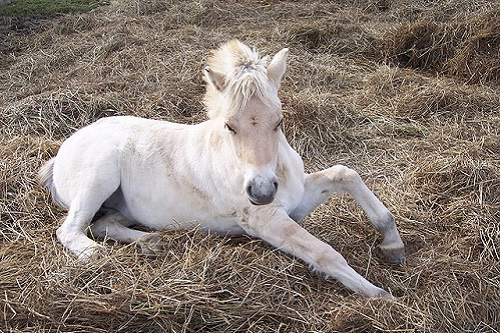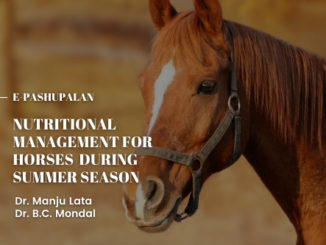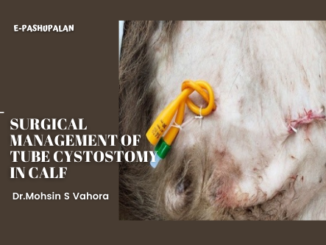Neonatal period is characterized by dramatic changes in many physiological events in foals. Changes occur rapidly, unlike adult horses the neonatal foal may appear normal and within a few hours may be so compromised as to be irretrievable. Also signs are often vague and may pass unnoticed which crate difficulties with diagnosis and treatment.

Neonatal emergencies are frequent during parturition and can be linked to both the foal and the dam’s diseases. Early awareness of the need for resuscitation is important, as are prompt attempts to avoid further damage, such as hypoxic ischemic encephalopathy or fatalities.
Initial approach
- Take through history as soon as the animal is presented
- I/nasal oxygen canula is placed, jugular vein preparation for catheterization
- Temperature, pulse rate, respiration rate is checked
- Rapid physical assessment of essential organ function is to be made
- Arterial blood sample for blood gas analysis and electrolyte analysis is obtained
- Indirect blood pressure is recorded
- Blood for lab analysis and culture is obtained immediately after jugular catheterization. This is followed by fluid administration
All this needs to be done within 10 minutes of animal presentation.
Initial examination of essential organs involves examination of oral, nasal and sclera mucus membranes, respiratory pattern, cardiac rhythm, apparent temperature gradient, abdominal auscultation and abdominal palpation.
Objectives of good history and performing a clinical examination is to establish
List of all the identifiable problems
- Differential diagnosis list
- Diagnosis and prognosis
- Logical treatment plan to maximize the chances of recovery
- Further diagnostic testing and alteration in medication.
A number of conditions can place a newborn foal in jeopardy
Fever: Rectal temperature over 102 F or under 99 F in a depressed foal requires immediate communication with your veterinarian.
Sepsis: (Major cause of death in foals less than 7 days old and is a common complication of other neonatal conditions such as prematurity or neonatal maladjustment);
Failure of passive transfer (transfer of antibodies from the mare to the foal via colostrum); or Neonatal Isoerythrolysis: Some mares develop antibodies to the red blood cells of their foals and these foals develop a condition known as NI (neonatal isoerythrolysis). The colostrum they consume contains antibodies which destroy their own red blood cells and causes icterus. This condition often develops at three to five days of age and can be treated successfully in the field if identified early.
Diarrhea and/or Colic: Diarrhea or colic in neonates is worrisome and immediate veterinary involvement is advised. Diarrhea puts the foal at risk for dehydration and can be caused by infectious agents, parasites, consumption of sand, overeating, lactose intolerance, or intestinal abnormalities. Common causes of neonatal colic include meconium impaction, viral or bacterial infection (infection type varies with age of foal), overfeeding, ruptured bladder (abdominal pain), gastric ulceration, and parasitism.
Hypoxic injury (oxygen deprivation in foals born from a difficult birth or with a congenital abnormality); Respiratory distress/ pneumonia: Labored respiration in the foal is a cause for concern. Any issue that impairs oxygen delivery can cause an increased rate or effort. Pneumonia can occur with septicemia and can be subtle in the foal. Foals often fail to cough or display abnormal lung sounds and often do not have any nasal discharge. A respiratory rate less than 20 or greater than 60 can be a significant cause for concern, and these foals often require oxygen supplementation in the NICU if the rapid respiratory rate is associated with respiratory abnormalities.
Ruptured bladder; Swollen or moist umbilicus (Patent urachus): The umbilicus is the second most likely route of entry for infectious agents in the foal, after the gut. Swelling or moisture warrant immediate investigation and can be indicative of infection or a patent urachus.
Seizures: Mild seizure activity in a foal can be as subtle as staring off into the distance with excessive blinking. Grand mal seizures often involve a loss of consciousness and large-scale tremoring in lateral recumbency. Immediate veterinary intervention is warranted.
Prematurity or dysmaturity (dysmaturity is the lack of development in a foal that has a normal gestation period)
Neonatal maladjustment syndrome
Other Causes
Lameness or swollen joints require immediate examination. Never assume the mare stepped on the foal. Neonatal lameness is often associated with sepsis and spread of infection to the joint or growth plate, often within the first 30 days of life.
Swollen, cloudy, or weeping eyes requires immediate veterinary attention. Common foal issues include corneal ulceration from shavings or stall trauma, entropion (folding of the lid into the cornea), or more seriously, uveitis. Uveitis in a newborn can indicate sepsis and carries a poor prognosis.
Laboratory analysis
In neonatal foals, normal values for blood clinical chemistry tests and hematology vary from those in adult horses. Shortly after birth, a normal 24-hour-old foal should have a 2:1 neutrophil:lymphocyte ratio. Premature foals have a low number of neutrophils and a high number of lymphocytes. Serum protein levels in foals are lower than in adults. For example the serum alkaline phosphatase, GGT (gamma glutamyltransferase), bilirubin and AST levels are elevated in normal foal. Normal creatinine level in foals 2-4mg/dl which decreases quickly afterwards and in foals born with fetal distress can have creatinine as high as 40mg/dl. The rapidity of decrease in creatinine after birth reflects renal function and more specifically GFR.
Lactate levels: high lactate levels are an important cause of acidosis. High levels of lactate can occur due to tissue hypoxia, hypodynamic shock, organ ischemia, hypermetabolism, increased protein catabolism, increased muscle activity and decreased lactate clearance (normal lactate levels in neonates- 3mmol/L)
Hyperlactatemia should always be taken as a sign of critical state of neonates. Correcting hypoperfusion if present is vital in this case.

Treatment and Management of ill patients
Bedding
Area where foal is kept should be covered with straw and well padded to prevent traumatic injuries. If required they should be covered with blankets.
Respiratory support
Arterial sample should be collected before putting the animal on intra nasal oxygen.
2nd arterial sample is collected after resuscitation and the values of two samples are compared to evaluate the rate of improvement.
Oxygen supply @ 5-10 Litre/minute (Endotrachel intubation- if required)
In hypercapnia- respiratory stimulants like doxapram/caffine @10mg/kg orally followed by 2.5mg/kg/day
Bronchodilators-theophyline, aminophyline, terbutaline
Nutritional support
In foals less than 24 hours administer cholostrum feed by nasogastric intubation to boost serum IgG levels. In older foals encourage the foal for milk suckling and during intensive care mare should be repeatedly milked as it is the best nutritional support foal can get. Indwelling nasogastric tube is method of choice.
If oral feeding cannot be maintained than parentral feeding must be considered. Hypoperfusion is usually secondary to hypovolumia due to poor vascular tone. Sick neonates are almost never dehydrated during first 48 hrs of life unless there is severe diarrhea, reflux or GI tract pooling of fluids or in rare cases of polyuria.
Critical neonates are often hyperhydrated but hypovolumic. So, care should be taken to optimize by not only administration of high volumes to correct the hypovolumia but also not to give excessive fluid volume that will further exacerbate the hyperhydration
Crystalloids/ colloids @20ml/kg boluses over 10-20 minutes (thus for 50 kg foal 1 liter bolus is rapidly given, usually within 10 minutes).
If PCV is less than 25%- blood transfusion is recommended
Inopressor therapy
In cases with adequate return of perfusion after 4-6 fluid boluses, initiate inopressor therapy.
Drugs used- Adnergic agonists (dopamine, dobutamine, norepinephrine, epinephrine), vasopressin and physiological doses of corticosteroids, nalaxone and NOS blockers (methylene blue).
While choosing drugs to support cardio-vascular system, it is important to ensure cardiac output. If pressors are given without inotropic support, there is danger that cardiac output and perfusion will be decreased (inspite of increased blood pressure). So, mixed inotropic and pressur support should be started as initial therapy.
Follow rule of i.e: 6*bodyweight= number of mg of drug that should be added to 100 ml of infusion fluids. Than for each 1ml/hr of infusion, patient will receive 1ug/kg/min of drug.
Dobutamine could be classified as inopressor at high doses. So when patients need support but are not in shock, a good starting dose is 5ug/kg/min followed by titration to the effective dose.
In case of shock starting dose is 10ug/kg/min (STD dose is 2-20ug/kg/min)
Dopamine (inopressor) – Given when patients need support but are not shocky @5ug/kg/min followed by effective titration. In case of shock starting dose is 10ug/kg/min (STD dose is 2-20ug/kg/min)
Norepinephrine- frequently used with either dopamine or dobutamine to enhance the inotropic effectbecause of strang pressor effect. Starting dose @0.3-0.5ug/kg/min with further titration to effective dose. (Range 0.1-3.0ug/kg/min)
Epinephrine- associated with hyperglycemia and increased lactate production (inotropic and inopressor activity). Starting dose @0.3-0.5ug/kg/min (Range 0.1-2ug/kg/min).
Vesopresin- used for treatment of hypotension associated with septic shock
| Drug | Dosage | Side effects |
| Dobutamine | 5ug/kg/min | Tachucardia, arrhythmia |
| Dopamine | 5ug/kg/min | Arrythemia |
| Norepinephrine | 0.3-0.5ug/kg/min | Arrythemia |
| Epinephrine | 0.3-0.5ug/kg/min | Arrhythemia, hyperglycemia |
| Vasopresin | 0.25-1.0mU/kg/min | Hyponatremia |
Dextrose therapy- @4-8mg/kg/min initially low rate of infusion followed by gradual increase over the first hours of therapy.
In septic shock infusion rate must be increased above 8mg/kg/min upto as high as 20mg/kg/min. in cases of exogenous glucose administration addition of thiamine to the fluids may help ensure proper metabolism.
In cases of hyperglycemia double check infusion rates. Hyperglycemia without insulin response may result in a degree of cellular dehydration, glucose dieresis with subsequent fluid and electrolyte wasting. If hyperglycemia is <250mg/dl and no significant glucose dieresis, than give neonates some time to develop its own innate response. If >250mg/dl, glucose diereses/persistently high without adaptation give- insulin therapy
Regular Insulin @ CRI is well tolerated by neonates- 0.00125-0.2U/kg/hr with most responding to <0.05U/kg
Maintenance fluid- Holliday segar formula @100ml/kg/day (4ml/kg/hr) for first 10kg body weight. 50ml/kg/day (2ml/kg/hr) for each kg from 11-20kg body weight. 25ml/kg/day (1ml/kg/hr) for each kg above 20kg body weight. Glucose infusion rate for a 50 kg foal is 2.5 times more than the calculated dose of holliday segar formula.
Sodium overload is a common sequel to indiscriminate fluid treatment with sodium containing fluids. Normal nursing foal receives 2mEqNa/kg/day from mare’s milk and requires 1mEqNa/kg/day for growth and sodium replacement should be limited to <3mEqNa/kg/day (for 50kg foal-1litre balanced ionic fluid or 1 liter of plasma will deliver its daily requirement of Na.). Foal receiving 2gm/kg/day of amino acids may be receiving 1mEqNa/kg/day.
Foals not consuming milk with high potassium content will require supplemental potassium therapy, empirical supplementation with 10-40mEq/L of fluid.
Temperature management
The foal is very susceptible to hypothermia, and body temperature changes in the neonate can cause problems. Foals that are exposed to cold temperatures and drafts lose heat by conduction. Excessive struggling and seizures may trigger severe hyperthermia, necessitating a complete cessation of body warming efforts. Hyperthermia raises caloric demands, compromises breathing and pulmonary function, and decreases the seizure threshold.
Disruption in CHO metabolism
The foal is born with low glycogen stocks in the liver, muscle, and brain. Blood glucose levels drop rapidly in the first two hours after foaling, and if the foal does not nurse within three hours, a source of milk or energy must be given. In sick neonatal foals, dextrose-containing fluids should be considered. Both entry data bases for ill neonatal foals include a STAT blood glucose test. Following a meal, normal blood sugar levels range from 80 mg/dl to 160 mg/dl. In poor foals who cannot obtain enough energy via the oral path, partial parenteral nutrition is widely used.
Antibiotic therapy
based on blood culture examination majority are gram negative , over 30% are gram positive and 15% have multiple isolates. Empirical choice for initial antimicrobial therapy should be broad spectrum.
Seizure
- Anticonvulsants, corticosteroids
- Diazepam @5-10mg/50kg iv every 30 minutes
- Detomidine @0.01mg/kg iv + butorphenol 0.02mg/kg
- Phenobarbital @10-20mg/kg diluted in in 30 ml sterile water
Cerebral edema
- Corticosteroids- dexamethasone @4mg/50kg q12h
- Mannitol @0.25g/kg as 20% solution iv over 15-3 minutes.
- Vitamin C @1000mg/50kg q12h
- Antiulcer medications, tetanus toxoids, analgesics, anti-inflammatory drugs, anti-diarrheal drugs
| The content of the articles are accurate and true to the best of the author’s knowledge. It is not meant to substitute for diagnosis, prognosis, treatment, prescription, or formal and individualized advice from a veterinary medical professional. Animals exhibiting signs and symptoms of distress should be seen by a veterinarian immediately. |







Be the first to comment